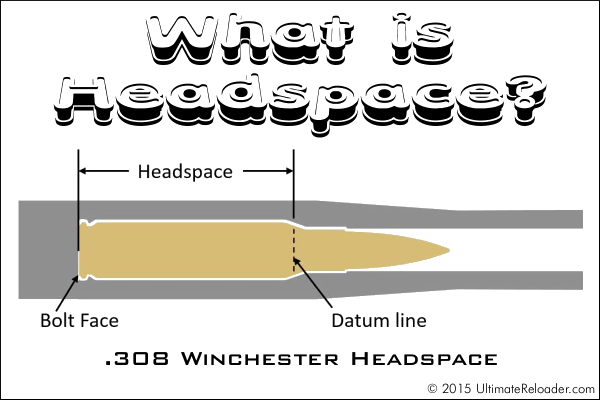This illustration shows the headspace measurement for popular.308 Winchester, which headspaces at the shoulder. Image copyright 2015 Ultimate reloader. Steve Ostrem, Brownells’ gun tech, explains the importance of headspace in this Brownells Tech Tip Video. This video is worth watching even if you are an experienced rifle shooter to refresh your understanding on headspace measurements and the correct usage of “GO” or “NO-GO”, gauges. Headspace Definition
In firearms, the headspace is the distance between the datum reference (the part of the chamber which stops the cartridge from moving forward) and the bolt face. Different cartridges have different datum lines positioned in relation to their cartridge. 5.56x45mm NATO ammunition has its headspace off the shoulder, while.303 British ammunition has its headspace off the forward rim. If the headspace of ammunition is too small, it may not chamber properly. If the headspace is too big, the ammunition may not fit or be designed as intended and the cartridge case could rupture, potentially damaging the firearm and the shooter. (Source: Wikipedia). Problems caused by too much headspace
Case separations, bulged/blown casings, split shoulders or unseated primers are all examples of excessive headspace. Case ruptures due to excessive headspace can cause catastrophic failures and serious injury. Headspace is a very important measurement. Too little headspace can cause problems.
Insufficient (or excessively tightened) headspace can cause the firearm to not go into battery. This will result in failure to fire, or deformation of cartridge cases. Cases with too little space can cause various feeding and function problems, even if the round can be chambered. Headspace Gauges
Two gauges are used to measure headspace: one “Go” and the other “No-Go”. Headspace gauges are made from heat-treated tooling steel and resemble cartridges. Gunsmiths need both a “Go-Go” and “No-Go”, in order to headspace a weapon properly. The “Field” gauge is used in the field (as its name suggests) to indicate the absolute safe maximum headspace. This gauge is used as over time the bolt, receiver, bolt, and lugs will wear out, and the receiver can stretch. All of these factors cause the headspace to increase from “factory specs”, which are measured by the “Go”, “No-Go”, and “Field” gauges. A bolt that closes only on “Field”, but not “No-Go”, is dangerous to fire and could malfunction with cartridges that are slightly outside of specification. You must understand Headspace Gauges, and how to use. There are gauges for “Go”, “No Go”, and “Field”. The “Field”, however, is the longest. Brownells explains that the GO gauge corresponds with the SAAMI minimum length of the chamber, while the FIELD is usually the maximum depth or slightly less. NO-GO gauges, which are technically voluntary, are an intermediate size between minimum and maximum. A firearm that does not close on the FIELD gauge but closes on the NO-GO gauge may not be accurate and have a very short cartridge life. ]”

















